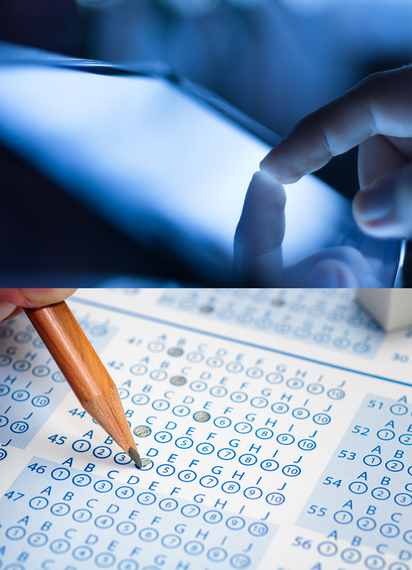According to Center for Curriculum Redesign (CCR) founder Charles Fadel, education is “falling behind its mission to prepare students for the future: a world that’s increasingly volatile, uncertain, complex and ambiguous.” Curriculum was significantly redesigned in the late 1800’s when societal and human capital needs demanded it. But the 21st century bears little resemblance to the past. WHAT should we teach young people in an age where Dr. Google has an answer for everything? Humans are living longer; the traditional professions disappear while new ones are created; international mobility is drastically increasing population diversity; terrorism, environmental threats and inequality need our collective attention; and robots and gene editing are coming, requiring us to re-examine the very core of what it means to be human. WHAT does all that we know now, and all that we still can only imagine, mean for Curriculum?
If we agree that the technological trends futurists are predicting will mean constant and dramatic changes for all, why aren’t we more focused on rethinking the WHAT of education i.e. WHAT curriculum will make education more relevant in the future?
According to Andreas Schleicher, Director for Education and Skills at the OECD, Fadel’s book, Four-Dimensional Education: The Competencies Learners Need to Succeed, provides a “first of its kind organizing framework of competencies needed for this century which defines the spaces in which educators, curriculum planners, policy makers and learners can establish WHAT should be learned.”
The Global Search for Education begins a five part series to discuss WHAT should students learn for the 21st century? We welcome Charles Fadel for Part 1: What is Four-Dimensional Education?

The unpredictable context requires a paradigm switch so that the goal of education is no longer to impart information but to teach students to navigate an ever-changing world. For this they will need versatility i.e. breadth as a hedge against rapidly changing conditions, an increased capability i.e. depth to engage with complex challenges, along with a diverse set of competencies such as adaptability, increased collaboration between cultures, etc. towards the goal of a sustainable humanity via fulfilled individuals.
What elements of curriculum do we need to change?
Traditional disciplines currently take up most of the available time and leave little space for newer subjects, branches and topics within traditional disciplines for example complex systems in mathematics, modern disciplines (e.g. entrepreneurship), interdisciplinary, cross-cutting themes, and competencies. Because of the vast amount of information that needs to be covered and the pressure of preparing for standardized tests, relatively few educators are able to consistently provide the time needed to effectively integrate new learning goals into the curriculum. We need to redesign curriculum to both broaden and deepen understanding; the current content will need to be re-examined with a fine-toothed comb. That process involves distilling each discipline into its core essential questions, and restructuring the information to highlight these concepts and meta-concepts as well as their processes, methods and tools. We need to examine the rationale behind each item; does it provide practical value for the future? Cognitive value for transfer and extension to other faculties? Emotional or aesthetic value due to its inherent beauty? These facets should be highlighted, and the items found to have no clear justification except inertia should be removed. This does not mean cutting out entire subjects by any means. The question is not whether students need to learn math, but which parts of math are no longer useful? For example, perhaps it is no longer useful to spend core curriculum time learning long division, or some algorithms of trigonometry.

Correct. The inertia is propelled at two levels: the policy level, and the level of human expertise and authority.
At the policy level, most countries must work with an inherent level of instability, with elections and changes of leadership occurring every few years. The frequent changes of personnel at both the staff level and the ministerial level, and the political pressures to balance the competing interests of voters, parents, unions, businesses, and so on, often preclude the continuity necessary to reflect on large-scale trends, plan for long-term goals, take calculated risks, or embrace change and innovation.
At the level of human expertise and authority, decisions are often reserved for subject-matter experts. These experts’ opinions are partial and biased in certain predictable ways. First, experts feel responsible for upholding earlier standards, as they have sometimes been part of creating them and promoting their benefits. Being loyal to their field of study, they also find it difficult to discard parts of the whole cloth of their field’s knowledge, even after those parts have become outdated.
Second, it is also very difficult for experts to add new disciplines to traditional fields of knowledge. For example, algorithmics and game theory are topics that are relevant for current advancements in a variety of fields that use mathematics, but tradition-oriented mathematics experts do not include them in their efforts to reform mathematics curriculum. Additionally, expert academics often operate in relative isolation from the demands of the real world, sometimes unaware of the ways their discipline is currently being applied in professional settings outside academia.
Finally, these subject-matter experts place a large emphasis on the ways others in their field around the world are accomplishing similar curriculum reviews. In trying to adjust to emulate the others, they are subject to groupthink, and together they are rarely able to be highly innovative.
We’re seeing a growing consensus among employers and world leaders that curriculum does not adequately prepare graduates for today’s workforce and world. Thoughts?
In addition to learning content deeply, students will need to apply that knowledge using “21st Century Skills”: Creativity, Critical Thinking, Communication, and Collaboration. But skills are only one further dimension. In addition to skills, students will need to learn Character qualities: how students engage and behave in the world. Policymakers are beginning to see their importance as part of a formal education, although educators and employers have known this for a long time. Despite what is traditionally conceived of as progress, for example, economic growth, material productivity, etc, countries are now tracking other indicators of social progress and the level of their responses to local and global challenges, for example, poverty, violence, corruption and sustainability. This highlights the need for students to develop and build positive character qualities in addition to the knowledge and skills most needed for success.
In order to deepen and enhance the learning in these three dimensions — Knowledge, Skills, and Character qualities–there is an important additional fourth dimension needed for a fully comprehensive twenty-first century education: Meta-Learning (often called learning to learn–the internal processes by which we reflect on and adapt our learning). It is not enough to implicitly include this fourth dimension in all the other dimensions–its significance must be highlighted explicitly, so that we are constantly reminded to incorporate meta-learning strategies into the knowledge, skills, and character portions of our learning experiences, learning how to strive to improve no matter what goals we set for ourselves.

Our framework is a result of the analysis and synthesis of research on learning sciences, views from futurists and economists, standards around the world, and needs of employers and societies — all organized to be maximally comprehensive, compact, appropriate, and globally relevant. By being able to consider all the necessary goals of a 21st Century curriculum at one time, policy makers, curriculum designers, teachers, and parents can more effectively make decisions about the future of education. The framework does not prescribe a particular path forward; rather it lays out the map clearly so that everyone can speak the same language about improvement, even as they create different instantiations of how to get there.
How can successful implementation be realized given the complexity of the issues?
At the policy level, we will need to strive toward a stable consensus among political factions, and clearly articulated vision of the kind of education students now need. At the level of disciplinary experts, there needs to be continuous involvement of real-world users of the disciplines, in addition to reform-minded academics.
We will need to leverage best practices from education systems around the world as well as industry where applicable. We must carefully re-examine the relevance of what we teach, curate the traditional disciplines, add relevant modern disciplines, and place emphasis on more holistic “whole student” learning–not just knowledge but also skills, character, and meta-learning. Finally, we will need the courage to innovate, letting go of the comfort of an existing system and working under conditions of uncertainty toward a better one.
Thank you Charles.
In Part 2 of our series with Charles Fadel, we will focus on WHAT Knowledge.

